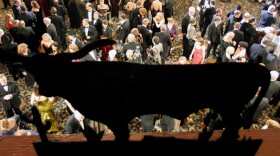This weekend, hundreds of thousands of people — including President Obama and his family — are participating in volunteer activities around the country. Saturday's National Day of Service kicks off the president's second inauguration and honors the Rev. Martin Luther King Jr.'s birthday.
As budgets tighten and personal schedules fill, nonprofits are looking for new ways to attract extra helpers, and organizers for the national event hope it will lead to a permanent boost in volunteerism.
Willingness To Give Back
Volunteers, by their very nature, are an upbeat crowd. That includes a group of a dozen volunteers who came to Tyler Elementary School in Washington, D.C., Friday to organize the school library. The library was kind of a mess, and the kids couldn't check out books. There's no librarian here because of school budget cuts.
It's one of thousands of service projects being held over this pre-inaugural weekend. Lisa McBride came with colleagues from her conference-planning company in Virginia. She says volunteering helps them to work together better, but it also just feels good.
"Some of us are so privileged, and other people, such as this school, run on volunteers like us and the willingness of people to volunteer and give back," she says.
That's what motivates lots of people: teenagers, working parents, retirees. Tens of millions of Americans volunteer each year. Still, the nation's volunteer rate is less than 27 percent, about the same as it's been over the past decade. Volunteer groups are trying to make that number grow.
Where There's A Will ...
Jacki Coyle and two of her colleagues from Shepherd's Table, a Maryland nonprofit, are setting up a booth in a huge tent on the National Mall. About 100 groups are participating there Saturday in what the Presidential Inaugural Committee calls a "Service Summit." The purpose is to help people learn about volunteering and to sign them up. Coyle says sometimes people doubt they can have any impact.
"Or somebody might feel ... overburdened. They have so many things in their life already," she says. "I would just say to people, if you give an hour once a month, that makes a difference."
Her organization, which serves the homeless, relies on more than 1,000 volunteers a year. Surprisingly, surveys show that those who volunteer the most are some of the busiest people around: working mothers.
'Microvolunteering'
Nearby, Jennifer Burnside of the Junior League of Northern Virginia, is setting up a booth so volunteers can make cards to cheer up children who are ill or homeless.
"Inside the card kit, you'll be able to use foam, stickers, glitter and glue, and write a special message for a child in need," she says.
Burnside says the key to attracting volunteers these days is flexibility, letting them help in the evenings, on weekends or from home. Maybe volunteers could even work online, helping a charity with recordkeeping, for example.
Michelle Nunn heads Points of Light, the nation's largest volunteer organization, which was inspired by another president, George H.W. Bush. She says nonprofits have to be more creative as needs grow but budgets tighten.
"There's now what we call sort of 'microvolunteering,' where if you actually have 15 minutes, there's little micro-assignments," she says. "You can help a nonprofit think about how they edit their funding letter or to come up with a great new slogan."
Or, she says, more retirees might be encouraged to volunteer with small stipends to help with transportation costs. Still, Nunn says the surest way to get people to help out has always been just to ask — which is what this weekend is all about.
Copyright 2020 NPR. To see more, visit https://www.npr.org. 9(MDAxNDQ2NDAxMDEyNzU2NzM2ODA3ZGI1ZA001))







